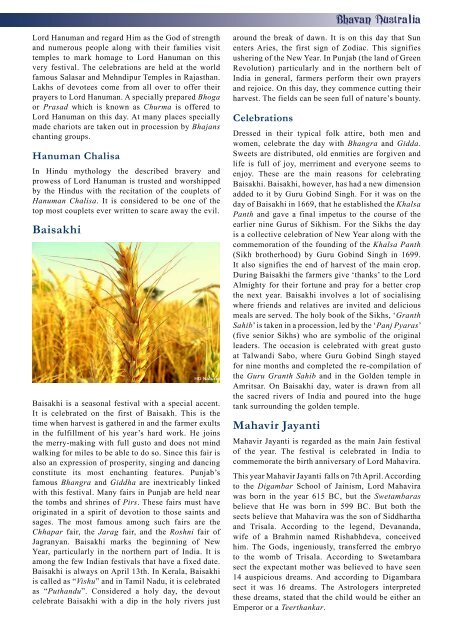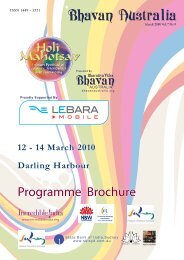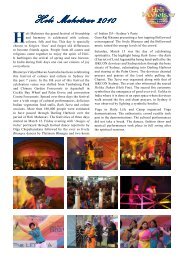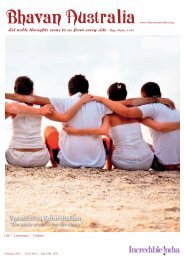'The whole world is but one family' - Bharatiya Vidya Bhavan Australia
'The whole world is but one family' - Bharatiya Vidya Bhavan Australia
'The whole world is but one family' - Bharatiya Vidya Bhavan Australia
You also want an ePaper? Increase the reach of your titles
YUMPU automatically turns print PDFs into web optimized ePapers that Google loves.
Lord Hanuman and regard Him as the God of strength<br />
and numerous people along with their families v<strong>is</strong>it<br />
temples to mark homage to Lord Hanuman on th<strong>is</strong><br />
very festival. The celebrations are held at the <strong>world</strong><br />
famous Salasar and Mehndipur Temples in Rajasthan.<br />
Lakhs of devotees come from all over to offer their<br />
prayers to Lord Hanuman. A specially prepared Bhoga<br />
or Prasad which <strong>is</strong> known as Churma <strong>is</strong> offered to<br />
Lord Hanuman on th<strong>is</strong> day. At many places specially<br />
made chariots are taken out in procession by Bhajans<br />
chanting groups.<br />
Hanuman Chal<strong>is</strong>a<br />
In Hindu mythology the described bravery and<br />
prowess of Lord Hanuman <strong>is</strong> trusted and worshipped<br />
by the Hindus with the recitation of the couplets of<br />
Hanuman Chal<strong>is</strong>a. It <strong>is</strong> considered to be <strong>one</strong> of the<br />
top most couplets ever written to scare away the evil.<br />
Ba<strong>is</strong>akhi<br />
Ba<strong>is</strong>akhi <strong>is</strong> a seasonal festival with a special accent.<br />
It <strong>is</strong> celebrated on the first of Ba<strong>is</strong>akh. Th<strong>is</strong> <strong>is</strong> the<br />
time when harvest <strong>is</strong> gathered in and the farmer exults<br />
in the fulfillment of h<strong>is</strong> year’s hard work. He joins<br />
the merry-making with full gusto and does not mind<br />
walking for miles to be able to do so. Since th<strong>is</strong> fair <strong>is</strong><br />
also an expression of prosperity, singing and dancing<br />
constitute its most enchanting features. Punjab’s<br />
famous Bhangra and Giddha are inextricably linked<br />
with th<strong>is</strong> festival. Many fairs in Punjab are held near<br />
the tombs and shrines of Pirs. These fairs must have<br />
originated in a spirit of devotion to those saints and<br />
sages. The most famous among such fairs are the<br />
Chhapar fair, the Jarag fair, and the Roshni fair of<br />
Jagranyan. Ba<strong>is</strong>akhi marks the beginning of New<br />
Year, particularly in the northern part of India. It <strong>is</strong><br />
among the few Indian festivals that have a fixed date.<br />
Ba<strong>is</strong>akhi <strong>is</strong> always on April 13th. In Kerala, Ba<strong>is</strong>akhi<br />
<strong>is</strong> called as “V<strong>is</strong>hu” and in Tamil Nadu, it <strong>is</strong> celebrated<br />
as “Puthandu”. Considered a holy day, the devout<br />
celebrate Ba<strong>is</strong>akhi with a dip in the holy rivers just<br />
around the break of dawn. It <strong>is</strong> on th<strong>is</strong> day that Sun<br />
enters Aries, the first sign of Zodiac. Th<strong>is</strong> signifies<br />
ushering of the New Year. In Punjab (the land of Green<br />
Revolution) particularly and in the northern belt of<br />
India in general, farmers perform their own prayers<br />
and rejoice. On th<strong>is</strong> day, they commence cutting their<br />
harvest. The fields can be seen full of nature’s bounty.<br />
Celebrations<br />
Dressed in their typical folk attire, both men and<br />
women, celebrate the day with Bhangra and Gidda.<br />
Sweets are d<strong>is</strong>tri<strong>but</strong>ed, old enmities are forgiven and<br />
life <strong>is</strong> full of joy, merriment and every<strong>one</strong> seems to<br />
enjoy. These are the main reasons for celebrating<br />
Ba<strong>is</strong>akhi. Ba<strong>is</strong>akhi, however, has had a new dimension<br />
added to it by Guru Gobind Singh. For it was on the<br />
day of Ba<strong>is</strong>akhi in 1669, that he establ<strong>is</strong>hed the Khalsa<br />
Panth and gave a final impetus to the course of the<br />
earlier nine Gurus of Sikh<strong>is</strong>m. For the Sikhs the day<br />
<strong>is</strong> a collective celebration of New Year along with the<br />
commemoration of the founding of the Khalsa Panth<br />
(Sikh brotherhood) by Guru Gobind Singh in 1699.<br />
It also signifies the end of harvest of the main crop.<br />
During Ba<strong>is</strong>akhi the farmers give ‘thanks’ to the Lord<br />
Almighty for their fortune and pray for a better crop<br />
the next year. Ba<strong>is</strong>akhi involves a lot of social<strong>is</strong>ing<br />
where friends and relatives are invited and delicious<br />
meals are served. The holy book of the Sikhs, ‘Granth<br />
Sahib’ <strong>is</strong> taken in a procession, led by the ‘Panj Pyaras’<br />
(five senior Sikhs) who are symbolic of the original<br />
leaders. The occasion <strong>is</strong> celebrated with great gusto<br />
at Talwandi Sabo, where Guru Gobind Singh stayed<br />
for nine months and completed the re-compilation of<br />
the Guru Granth Sahib and in the Golden temple in<br />
Amritsar. On Ba<strong>is</strong>akhi day, water <strong>is</strong> drawn from all<br />
the sacred rivers of India and poured into the huge<br />
tank surrounding the golden temple.<br />
Mahavir Jayanti<br />
Mahavir Jayanti <strong>is</strong> regarded as the main Jain festival<br />
of the year. The festival <strong>is</strong> celebrated in India to<br />
commemorate the birth anniversary of Lord Mahavira.<br />
Th<strong>is</strong> year Mahavir Jayanti falls on 7th April. According<br />
to the Digambar School of Jain<strong>is</strong>m, Lord Mahavira<br />
was born in the year 615 BC, <strong>but</strong> the Swetambaras<br />
believe that He was born in 599 BC. But both the<br />
sects believe that Mahavira was the son of Siddhartha<br />
and Tr<strong>is</strong>ala. According to the legend, Devananda,<br />
wife of a Brahmin named R<strong>is</strong>habhdeva, conceived<br />
him. The Gods, ingeniously, transferred the embryo<br />
to the womb of Tr<strong>is</strong>ala. According to Swetambara<br />
sect the expectant mother was believed to have seen<br />
14 auspicious dreams. And according to Digambara<br />
sect it was 16 dreams. The Astrologers interpreted<br />
these dreams, stated that the child would be either an<br />
Emperor or a Teerthankar.









